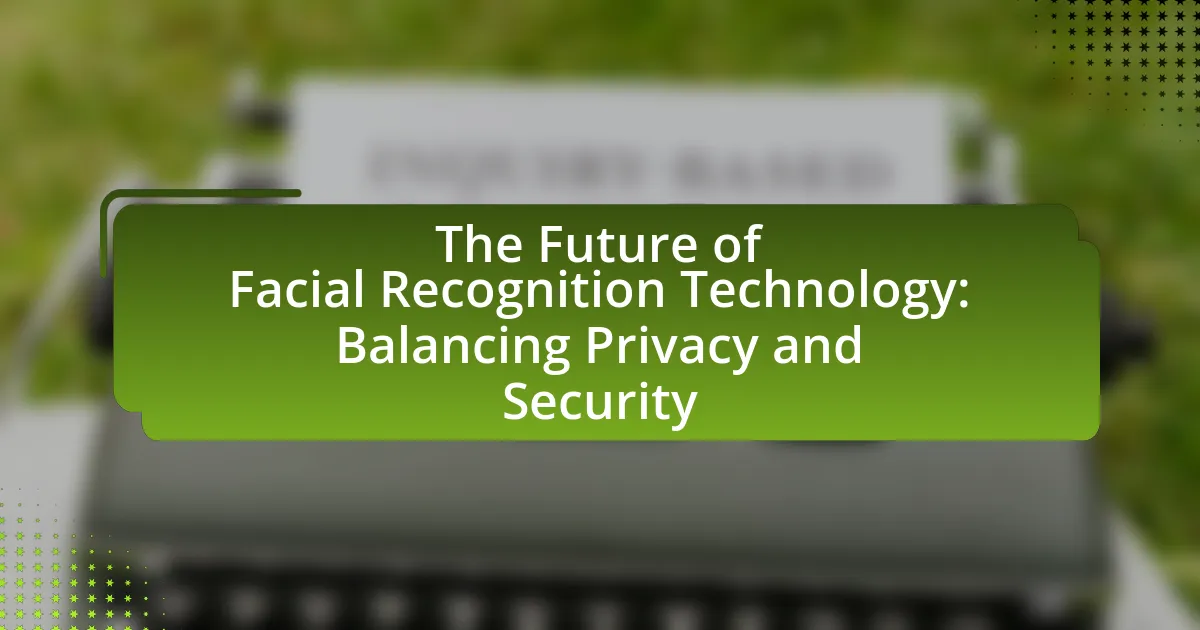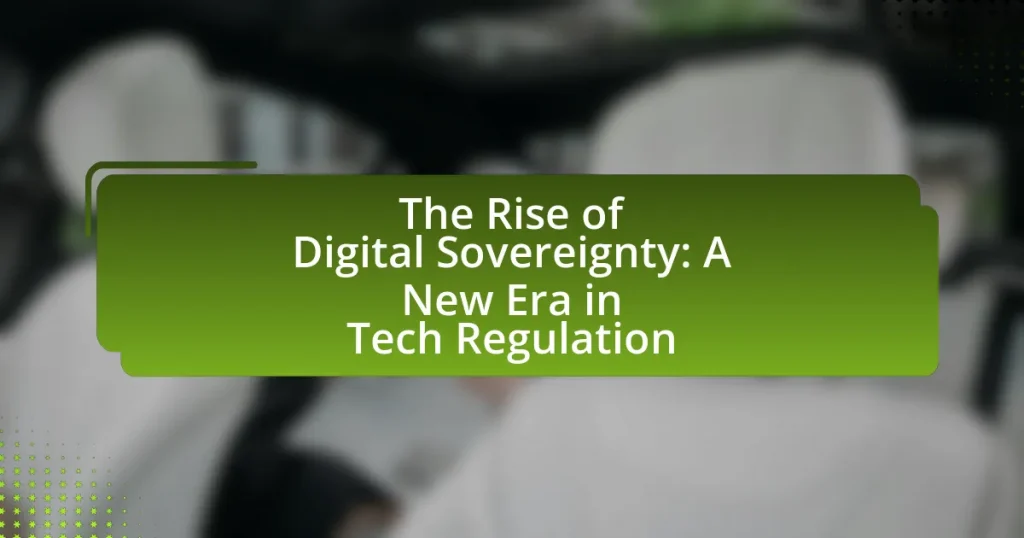Facial recognition technology is rapidly evolving, with advancements in accuracy and applications across various sectors such as law enforcement, security, and retail. This article examines the current uses of facial recognition, its key applications, and the expected technological innovations that will enhance its effectiveness. It also addresses the significant privacy concerns associated with the technology, including potential biases and the impact on individual rights, while exploring the legal and ethical implications of its deployment. Furthermore, the article discusses strategies for balancing privacy and security, emphasizing the importance of regulatory frameworks and public trust in the future of facial recognition technology.
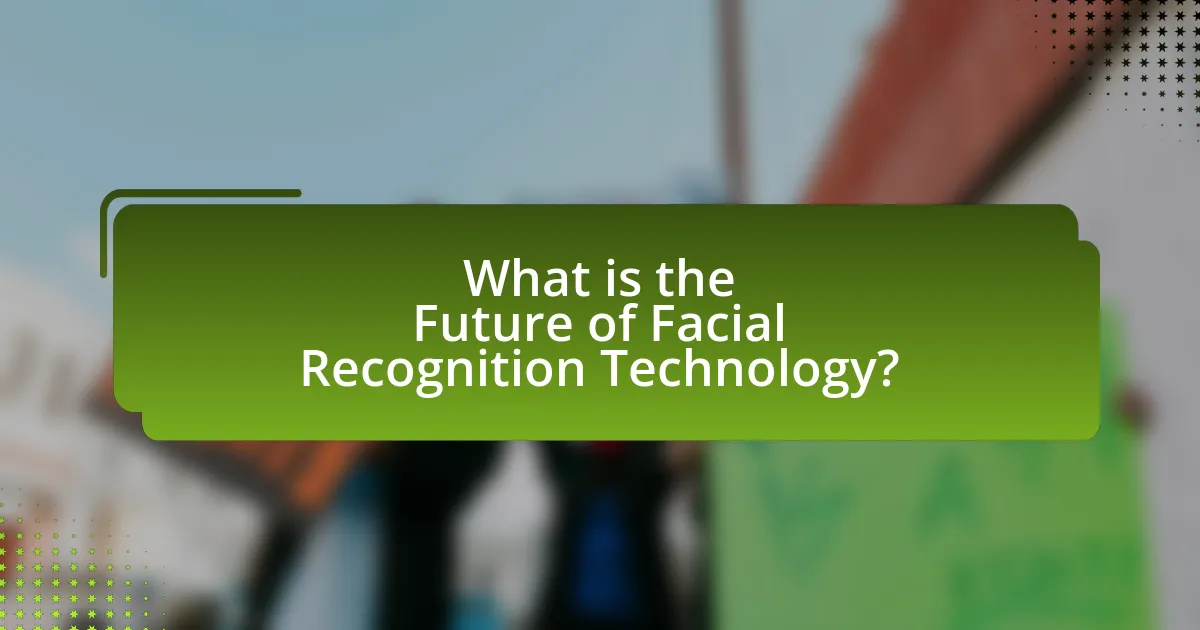
What is the Future of Facial Recognition Technology?
The future of facial recognition technology is poised for significant advancements, particularly in accuracy and application across various sectors. As algorithms improve, the technology is expected to achieve higher precision rates, reducing false positives and negatives, which currently hinder its reliability. For instance, a study by the National Institute of Standards and Technology (NIST) in 2020 demonstrated that the best facial recognition algorithms could achieve error rates as low as 0.1% under optimal conditions.
Moreover, the integration of facial recognition in security systems, retail, and personal devices is likely to expand, driven by increasing demand for enhanced security measures and user convenience. However, this growth will necessitate a careful balance between technological benefits and privacy concerns, as public scrutiny regarding data protection and ethical use intensifies. Legislative frameworks are expected to evolve, addressing these concerns while allowing for innovation in the field.
How is facial recognition technology currently being used?
Facial recognition technology is currently being used in various sectors, including law enforcement, security, and retail. In law enforcement, agencies utilize facial recognition to identify suspects in criminal investigations, with studies indicating that it can improve the speed and accuracy of suspect identification. Security systems in public spaces, such as airports and stadiums, employ facial recognition to enhance safety by monitoring crowds and identifying potential threats. Retailers use this technology to analyze customer behavior and improve service by recognizing loyal customers and personalizing marketing efforts. According to a report by the National Institute of Standards and Technology, the accuracy of facial recognition systems has significantly improved, making them more reliable for these applications.
What are the key applications of facial recognition technology today?
The key applications of facial recognition technology today include security and surveillance, user authentication, and marketing analytics. In security and surveillance, law enforcement agencies utilize facial recognition to identify suspects and enhance public safety; for instance, the FBI employs this technology to match faces against its database of criminal records. In user authentication, companies like Apple and Samsung use facial recognition for secure access to devices, enhancing user privacy and security. Additionally, in marketing analytics, retailers analyze customer demographics and behavior through facial recognition to tailor advertising strategies, improving customer engagement and sales. These applications demonstrate the technology’s versatility and growing importance across various sectors.
How do different industries implement facial recognition technology?
Different industries implement facial recognition technology in various ways to enhance security, streamline operations, and improve customer experiences. In the security sector, law enforcement agencies utilize facial recognition for identifying suspects and solving crimes, with studies indicating that such systems can improve identification accuracy by up to 95%. Retailers adopt this technology for loss prevention and customer analytics, allowing them to track shopper behavior and personalize marketing strategies. The healthcare industry employs facial recognition for patient identification and access control, ensuring that sensitive medical records are protected; a report from the Journal of Medical Systems highlights a 30% reduction in patient misidentification errors when using this technology. Additionally, the banking sector integrates facial recognition for secure transactions and fraud prevention, with a significant increase in customer satisfaction reported when using biometric authentication methods.
What advancements are expected in facial recognition technology?
Advancements in facial recognition technology are expected to include improved accuracy through the integration of deep learning algorithms, enhanced real-time processing capabilities, and increased robustness against spoofing attacks. Research indicates that the accuracy of facial recognition systems has improved significantly, with some models achieving over 99% accuracy in controlled environments. Additionally, advancements in edge computing are anticipated to allow for faster processing of facial recognition data on devices, reducing latency and increasing efficiency. Furthermore, the development of ethical frameworks and regulations is expected to shape the deployment of these technologies, ensuring a balance between security needs and privacy concerns.
What technological innovations are driving the future of facial recognition?
Technological innovations driving the future of facial recognition include advancements in deep learning algorithms, improved camera technology, and enhanced data processing capabilities. Deep learning algorithms, particularly convolutional neural networks (CNNs), have significantly increased the accuracy and speed of facial recognition systems, enabling real-time processing and better handling of diverse lighting and angles. Improved camera technology, such as high-resolution sensors and infrared imaging, allows for clearer and more detailed facial captures, even in low-light conditions. Additionally, enhanced data processing capabilities, driven by powerful GPUs and cloud computing, facilitate the analysis of large datasets, improving the overall efficiency and effectiveness of facial recognition systems. These innovations collectively contribute to more reliable and versatile applications in security, law enforcement, and personal devices.
How will artificial intelligence impact facial recognition technology?
Artificial intelligence will significantly enhance facial recognition technology by improving accuracy and efficiency in identifying individuals. AI algorithms, particularly deep learning models, can analyze vast datasets of facial images, leading to higher precision in recognizing faces under various conditions, such as different lighting or angles. For instance, a study published in the journal “Nature” demonstrated that AI-driven facial recognition systems achieved over 99% accuracy in controlled environments, showcasing the potential for AI to refine this technology. Additionally, AI can facilitate real-time processing, enabling quicker identification in security applications, which is crucial for law enforcement and public safety.
What are the potential benefits of facial recognition technology?
Facial recognition technology offers several potential benefits, including enhanced security, improved identification processes, and increased efficiency in various sectors. Enhanced security is evident in law enforcement, where facial recognition can help identify suspects quickly, leading to faster resolutions of crimes. For instance, a study by the National Institute of Standards and Technology found that facial recognition systems can achieve accuracy rates exceeding 99% in controlled environments. Improved identification processes are seen in customer service, where businesses use facial recognition to personalize experiences and streamline transactions. Additionally, increased efficiency is notable in airports, where facial recognition can expedite passenger processing, reducing wait times significantly. These benefits illustrate the technology’s potential to transform security and operational efficiency across multiple domains.
How can facial recognition enhance security measures?
Facial recognition enhances security measures by enabling accurate identification and verification of individuals in real-time. This technology can significantly reduce unauthorized access to secure areas, as systems equipped with facial recognition can quickly match faces against databases of known individuals, including criminals or unauthorized personnel. For instance, a study by the National Institute of Standards and Technology (NIST) found that modern facial recognition algorithms can achieve accuracy rates exceeding 99%, making them highly effective for security applications. Additionally, facial recognition can assist in monitoring public spaces, helping law enforcement agencies identify suspects in real-time, thereby improving response times and overall public safety.
What role does facial recognition play in improving user experiences?
Facial recognition enhances user experiences by enabling personalized interactions and streamlined access to services. This technology allows systems to identify users quickly, reducing the time spent on authentication processes, such as logging into devices or applications. For instance, a study by the National Institute of Standards and Technology (NIST) found that facial recognition systems can achieve accuracy rates exceeding 99%, significantly improving user satisfaction by minimizing friction in user interfaces. Additionally, businesses leverage facial recognition to tailor services based on user preferences, creating a more engaging and customized experience.
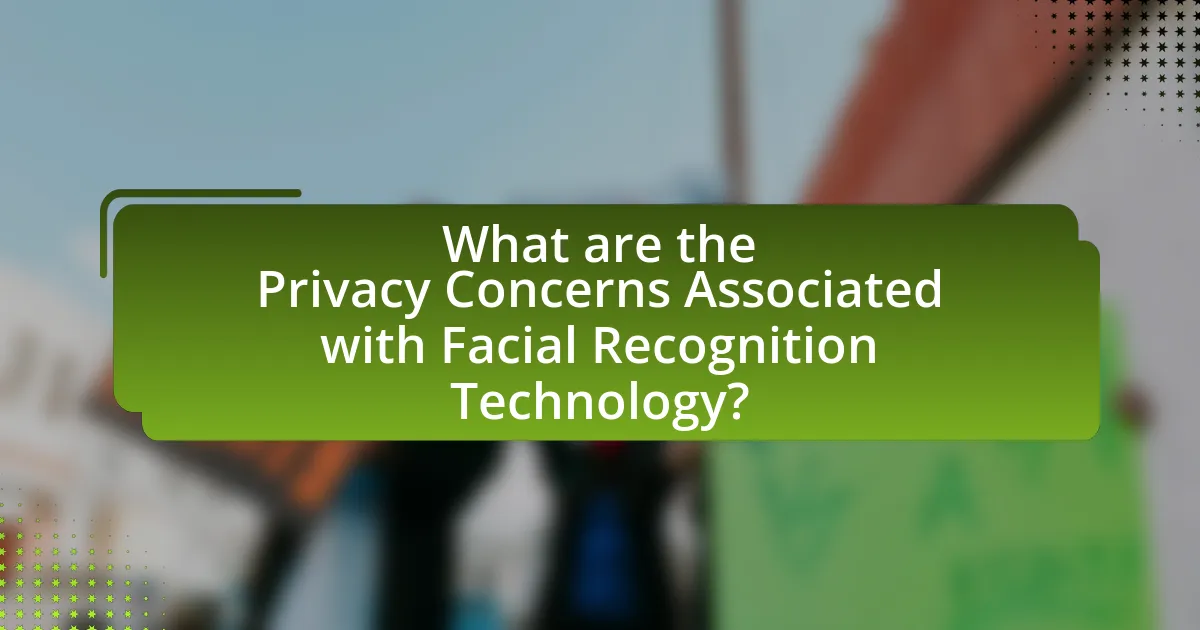
What are the Privacy Concerns Associated with Facial Recognition Technology?
Facial recognition technology raises significant privacy concerns primarily due to its potential for mass surveillance and unauthorized data collection. This technology can identify individuals without their consent, leading to violations of personal privacy and civil liberties. For instance, studies have shown that law enforcement agencies can use facial recognition to track individuals in public spaces, creating a chilling effect on free expression and assembly. Furthermore, the accuracy of facial recognition systems can be biased, disproportionately misidentifying people of color and women, which raises ethical concerns about fairness and discrimination. According to a report by the National Institute of Standards and Technology, facial recognition algorithms have higher error rates for these demographics, highlighting the need for stringent regulations to protect privacy rights.
How does facial recognition technology impact individual privacy rights?
Facial recognition technology significantly impacts individual privacy rights by enabling the mass collection and analysis of personal biometric data without explicit consent. This technology allows governments and private entities to track individuals’ movements and behaviors in public spaces, raising concerns about surveillance and the erosion of anonymity. For instance, a 2020 study by the American Civil Liberties Union found that facial recognition systems misidentified people of color at rates significantly higher than white individuals, highlighting potential biases and privacy violations. Furthermore, legislation in various jurisdictions, such as California’s Consumer Privacy Act, reflects growing recognition of the need to protect individuals’ privacy rights in the face of advancing surveillance technologies.
What are the legal implications of using facial recognition technology?
The legal implications of using facial recognition technology include potential violations of privacy rights, discrimination concerns, and regulatory compliance issues. Various jurisdictions have enacted laws that restrict or regulate the use of facial recognition, such as the General Data Protection Regulation (GDPR) in the European Union, which mandates explicit consent for data processing. Additionally, the technology can lead to biased outcomes, as studies have shown that facial recognition systems may misidentify individuals from certain demographic groups, raising legal questions about discrimination and equal protection under the law. Furthermore, organizations utilizing this technology must navigate a complex landscape of state and federal regulations, which may impose penalties for non-compliance.
How do different countries regulate facial recognition technology?
Different countries regulate facial recognition technology through a variety of legal frameworks and policies that reflect their cultural values and privacy concerns. For instance, the European Union has implemented the General Data Protection Regulation (GDPR), which imposes strict guidelines on data processing, including facial recognition, requiring explicit consent and justifiable purposes for data use. In contrast, the United States lacks a comprehensive federal law governing facial recognition, leading to a patchwork of state-level regulations, such as those in California, which require transparency and accountability from companies using the technology. China, on the other hand, has embraced facial recognition for surveillance and public safety, with minimal restrictions, reflecting its prioritization of security over privacy. These regulatory approaches illustrate the diverse ways countries balance privacy and security in the context of facial recognition technology.
What are the ethical considerations surrounding facial recognition technology?
The ethical considerations surrounding facial recognition technology include privacy invasion, potential for misuse, bias and discrimination, and lack of accountability. Privacy invasion occurs as individuals may be identified and tracked without their consent, undermining personal autonomy. Misuse can arise from surveillance practices that target specific groups, leading to oppressive monitoring. Bias and discrimination are significant concerns, as studies, such as those by the National Institute of Standards and Technology, have shown that facial recognition systems often misidentify individuals from minority groups at higher rates. Lastly, the lack of accountability in the deployment of this technology raises questions about who is responsible for errors or abuses, emphasizing the need for regulatory frameworks to ensure ethical use.
How can bias in facial recognition algorithms affect privacy?
Bias in facial recognition algorithms can significantly compromise individual privacy by leading to misidentification and disproportionate surveillance of marginalized groups. When algorithms are trained on biased datasets, they often produce inaccurate results, particularly for people of color and women, which can result in wrongful accusations or increased scrutiny from law enforcement. For instance, a study by the National Institute of Standards and Technology (NIST) found that facial recognition systems had higher error rates for Black individuals compared to white individuals, with some algorithms misidentifying Black women up to 34% of the time. This systemic bias not only infringes on personal privacy but also perpetuates discrimination, as affected individuals may face unwarranted surveillance or profiling based on flawed technology.
What measures can be taken to ensure ethical use of facial recognition technology?
To ensure the ethical use of facial recognition technology, implementing strict regulatory frameworks is essential. These frameworks should include guidelines for transparency, requiring organizations to disclose their use of facial recognition systems and the purposes for which they are employed. Additionally, establishing consent protocols is crucial, ensuring that individuals are informed and can opt-out of being recognized.
Moreover, regular audits and assessments of facial recognition systems can help identify biases and inaccuracies, as studies have shown that these technologies can disproportionately misidentify individuals from certain demographic groups. For instance, a study by the National Institute of Standards and Technology found that facial recognition algorithms had higher error rates for Black and Asian faces compared to White faces.
Finally, fostering public discourse and involving community stakeholders in the development and deployment of these technologies can enhance accountability and trust. By taking these measures, the ethical use of facial recognition technology can be better ensured, balancing privacy and security effectively.
What are the public perceptions of facial recognition technology?
Public perceptions of facial recognition technology are largely mixed, with significant concerns about privacy and surveillance. A 2021 Pew Research Center survey found that 56% of Americans believe the use of facial recognition technology by law enforcement raises more privacy concerns than benefits. Additionally, 79% of respondents expressed concern about the potential for misuse of this technology. These statistics highlight a prevalent skepticism regarding the implications of facial recognition on individual privacy and civil liberties, indicating that while some see its potential for enhancing security, many prioritize the protection of personal privacy over its benefits.
How do societal attitudes towards privacy influence the acceptance of facial recognition?
Societal attitudes towards privacy significantly influence the acceptance of facial recognition technology. When individuals prioritize privacy and express concerns about surveillance, they are less likely to accept facial recognition systems, fearing misuse and erosion of personal freedoms. For instance, a 2020 Pew Research Center survey found that 79% of Americans expressed concern about how facial recognition technology could be used by the government, indicating a strong link between privacy concerns and resistance to adoption. Conversely, in societies where privacy is less emphasized, acceptance of facial recognition tends to be higher, as seen in some Asian countries where security and convenience are prioritized over privacy. This demonstrates that societal norms and values directly shape the public’s willingness to embrace facial recognition technology.
What are the common misconceptions about facial recognition technology?
Common misconceptions about facial recognition technology include the belief that it is infallible, that it can identify individuals in any condition, and that it is universally used without regulation. Many people assume that facial recognition systems are 100% accurate; however, studies, such as those conducted by the National Institute of Standards and Technology (NIST), have shown that accuracy can vary significantly based on factors like lighting, angle, and demographic differences. Additionally, some believe that facial recognition can work effectively in all environments, but real-world applications often face challenges such as occlusions or poor image quality. Lastly, the misconception that facial recognition technology is unregulated overlooks the fact that various jurisdictions have implemented laws and guidelines to govern its use, aiming to balance privacy concerns with security needs.
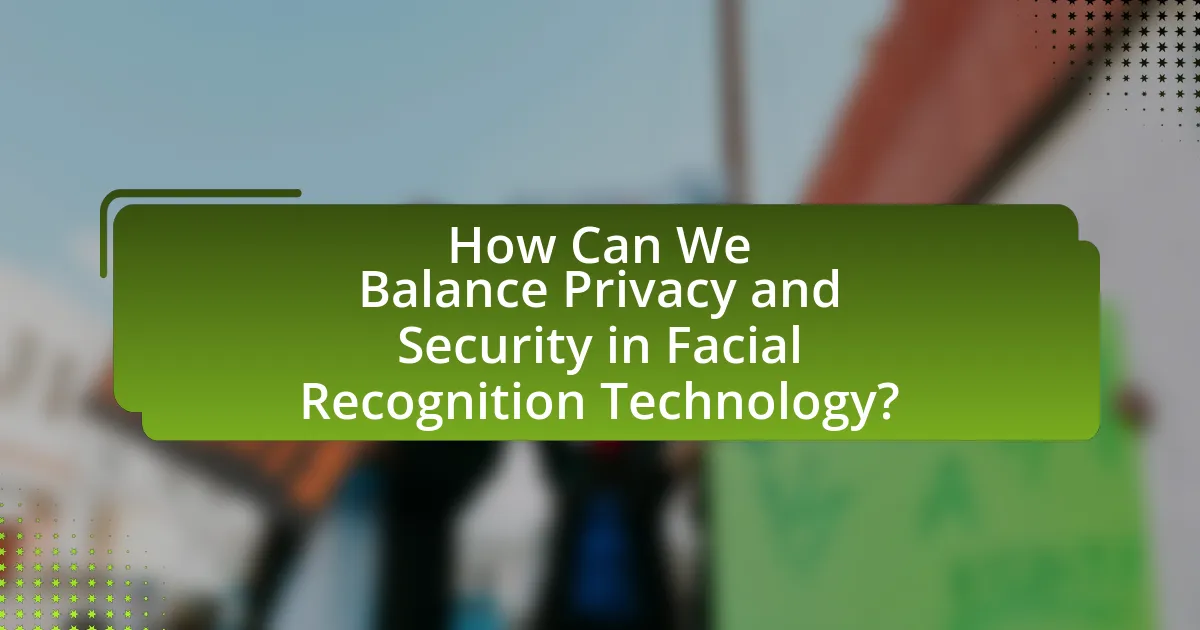
How Can We Balance Privacy and Security in Facial Recognition Technology?
To balance privacy and security in facial recognition technology, implementing strict regulations and transparency measures is essential. Regulations can establish clear guidelines on data collection, usage, and retention, ensuring that individuals’ privacy rights are protected while allowing law enforcement and security agencies to utilize the technology effectively. For instance, the General Data Protection Regulation (GDPR) in Europe mandates that organizations must have a legitimate purpose for processing personal data, which includes facial recognition data. Additionally, transparency measures, such as informing individuals when their data is being collected and providing them with the option to opt-out, can enhance public trust. Studies have shown that when people are aware of how their data is used and have control over it, they are more likely to accept the technology, thereby achieving a balance between privacy and security.
What strategies can be implemented to protect privacy while using facial recognition?
To protect privacy while using facial recognition, strategies such as data minimization, user consent, and robust encryption should be implemented. Data minimization involves collecting only the necessary facial data required for specific purposes, thereby reducing the risk of misuse. User consent ensures that individuals are informed and agree to the use of their facial data, promoting transparency and control over personal information. Robust encryption protects stored facial data from unauthorized access, making it difficult for malicious actors to exploit the information. These strategies align with privacy regulations like the General Data Protection Regulation (GDPR), which emphasizes the importance of protecting personal data and ensuring individuals’ rights.
How can transparency in facial recognition systems enhance public trust?
Transparency in facial recognition systems can enhance public trust by providing clear information about how data is collected, used, and protected. When individuals understand the processes and safeguards in place, they are more likely to feel secure and confident in the technology. For instance, studies have shown that when organizations disclose their data handling practices, public acceptance increases; a 2020 survey indicated that 70% of respondents were more comfortable with facial recognition when informed about its ethical use and data protection measures. This openness fosters accountability and allows for public scrutiny, which can further build trust in the system.
What role do data protection regulations play in balancing privacy and security?
Data protection regulations play a crucial role in balancing privacy and security by establishing legal frameworks that govern the collection, use, and storage of personal data. These regulations, such as the General Data Protection Regulation (GDPR) in the European Union, mandate that organizations implement strict measures to protect individuals’ privacy while allowing for necessary security practices. For instance, GDPR requires organizations to conduct Data Protection Impact Assessments (DPIAs) when implementing technologies like facial recognition, ensuring that privacy risks are identified and mitigated. This regulatory oversight helps to prevent misuse of data and fosters public trust, as individuals are more likely to accept security measures when they know their privacy is protected by law.
How can technology developers address privacy concerns in facial recognition?
Technology developers can address privacy concerns in facial recognition by implementing robust data protection measures and ensuring transparency in data usage. Developers should adopt privacy-by-design principles, which involve integrating privacy features into the technology from the outset, such as anonymizing data and limiting data retention periods. Additionally, they can enhance user consent mechanisms, allowing individuals to have control over their data and how it is used. Research indicates that 79% of consumers are concerned about how their facial recognition data is used, highlighting the need for developers to prioritize user trust and privacy. By adhering to regulations like the General Data Protection Regulation (GDPR), developers can further ensure compliance and protect user rights.
What best practices should developers follow to ensure ethical facial recognition technology?
Developers should implement transparency, user consent, and bias mitigation as best practices to ensure ethical facial recognition technology. Transparency involves clearly communicating how facial recognition systems work and the data they collect, which fosters trust and accountability. User consent requires obtaining explicit permission from individuals before their facial data is captured or processed, aligning with privacy regulations such as GDPR. Bias mitigation entails regularly auditing algorithms for fairness and accuracy across diverse demographic groups, as studies have shown that facial recognition systems can exhibit significant bias, leading to misidentification and discrimination. For instance, a 2019 study by the National Institute of Standards and Technology found that many facial recognition algorithms had higher error rates for people of color compared to white individuals. By adhering to these practices, developers can promote ethical standards in the deployment of facial recognition technology.
How can user consent be effectively integrated into facial recognition systems?
User consent can be effectively integrated into facial recognition systems by implementing clear opt-in mechanisms that require explicit agreement from individuals before their data is collected or processed. This approach ensures that users are fully informed about how their facial data will be used, stored, and shared, thereby enhancing transparency and trust. Research indicates that systems incorporating user consent protocols, such as the General Data Protection Regulation (GDPR) in Europe, have led to increased user confidence and compliance with privacy standards. By prioritizing user autonomy and providing straightforward consent options, facial recognition systems can align with ethical practices while maintaining security objectives.
What are the future implications of balancing privacy and security in facial recognition technology?
The future implications of balancing privacy and security in facial recognition technology include the potential for enhanced surveillance capabilities alongside significant privacy concerns. As governments and organizations increasingly adopt facial recognition systems for security purposes, the risk of misuse and overreach grows, potentially leading to violations of individual privacy rights. For instance, a study by the American Civil Liberties Union (ACLU) highlights that facial recognition technology can disproportionately impact marginalized communities, raising ethical questions about its deployment. Furthermore, regulatory frameworks may evolve to address these concerns, necessitating a careful approach to ensure that security measures do not infringe upon personal freedoms. This balance will be crucial in shaping public trust and acceptance of the technology in the future.
How might evolving technologies change the landscape of privacy and security in facial recognition?
Evolving technologies will significantly alter the landscape of privacy and security in facial recognition by enhancing accuracy and enabling real-time data processing. Advanced algorithms, such as deep learning, improve the precision of facial recognition systems, which can lead to increased surveillance capabilities. For instance, a study by the National Institute of Standards and Technology (NIST) found that modern facial recognition algorithms can achieve accuracy rates exceeding 99%, which raises concerns about potential misuse in tracking individuals without consent. Additionally, the integration of artificial intelligence can facilitate the analysis of vast amounts of data, potentially infringing on personal privacy. As these technologies advance, regulatory frameworks will need to adapt to address the balance between security benefits and privacy rights, as evidenced by ongoing discussions in various jurisdictions regarding the ethical implications of facial recognition deployment.
What lessons can be learned from current implementations of facial recognition technology?
Current implementations of facial recognition technology highlight the importance of balancing security and privacy. For instance, studies show that while facial recognition can enhance security measures, such as in law enforcement and public safety, it often raises significant privacy concerns, particularly regarding surveillance and data misuse. A report by the National Institute of Standards and Technology (NIST) found that facial recognition systems can exhibit biases, leading to higher false positive rates for certain demographic groups, which underscores the need for ethical considerations in deployment. Additionally, public backlash against invasive surveillance practices has prompted some jurisdictions to impose moratoriums or regulations on the use of facial recognition technology, demonstrating the necessity for transparent policies and public engagement in its implementation.
What practical steps can individuals take to protect their privacy in a world with facial recognition technology?
Individuals can protect their privacy in a world with facial recognition technology by adopting several practical measures. First, they should limit the amount of personal information shared online, as this reduces the data available for facial recognition systems to analyze. Second, using privacy-focused tools such as virtual private networks (VPNs) and encrypted messaging apps can help safeguard personal communications and online activities from surveillance. Third, individuals can opt for clothing or accessories that obscure facial features, such as hats or masks, which can hinder facial recognition systems. Additionally, they should stay informed about local laws and regulations regarding facial recognition technology to advocate for stronger privacy protections. Research indicates that public awareness and advocacy can lead to more stringent regulations, as seen in cities like San Francisco, which have implemented bans on facial recognition technology by city agencies.
